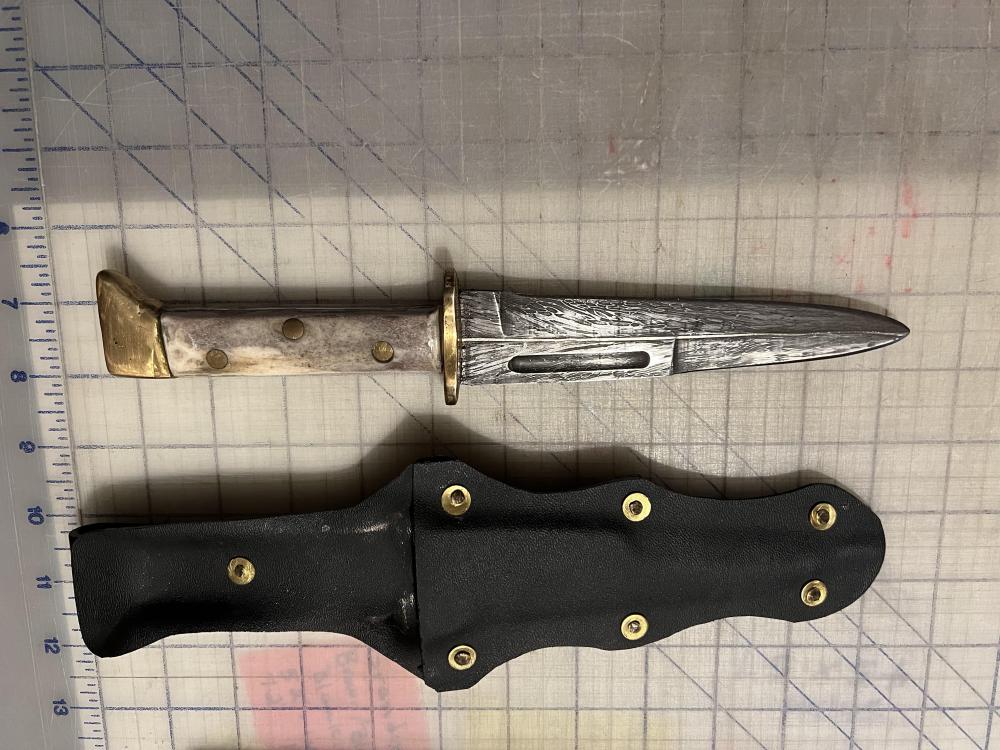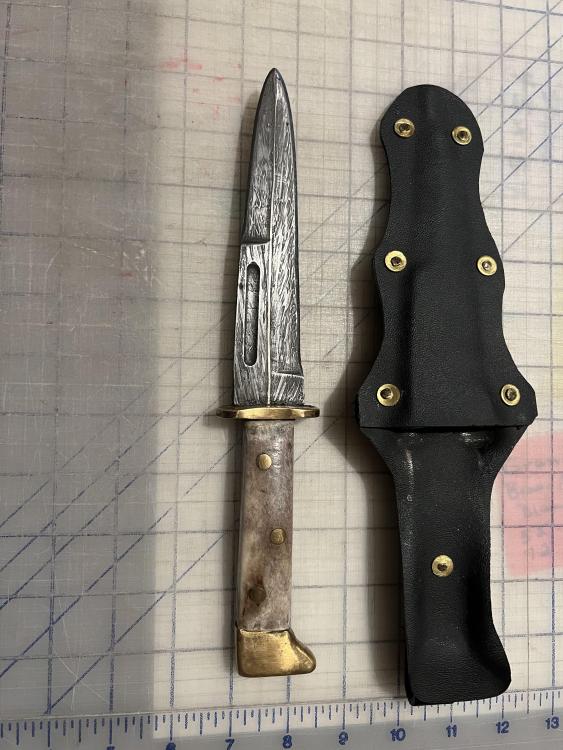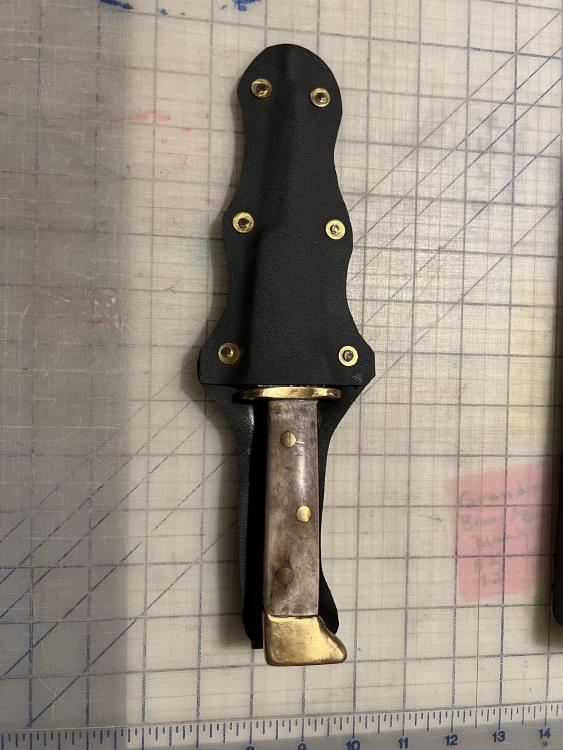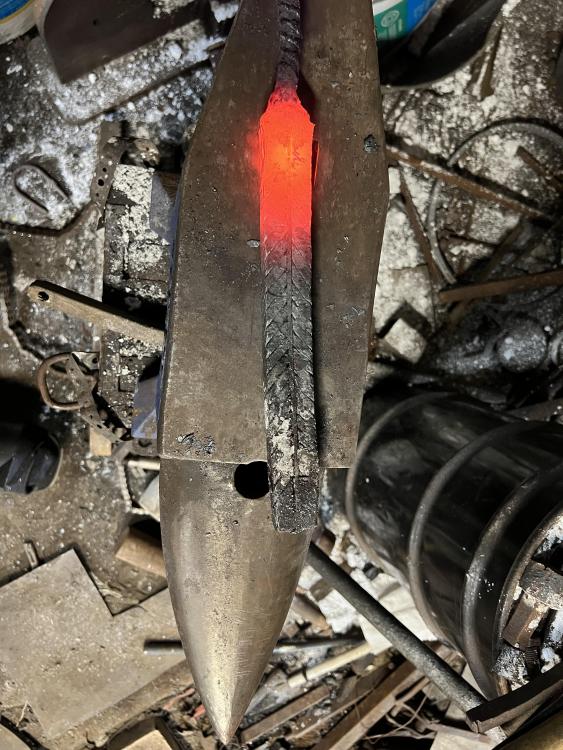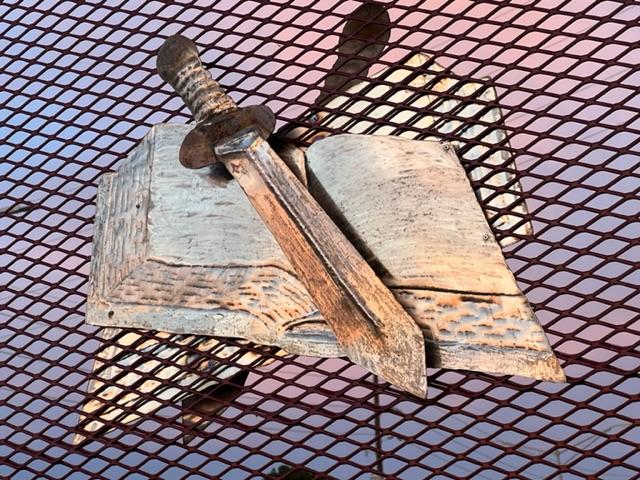-
Posts
421 -
Joined
-
Last visited
Content Type
Profiles
Forums
Articles
Gallery
Downloads
Events
Everything posted by Purple Bullet
-
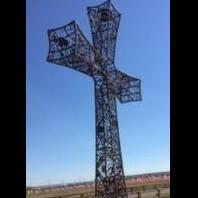
So I want to melt/smelt some brass...
Purple Bullet replied to Apocalypse's topic in Smelting, Melting, Foundry, and Casting
It may not be necessary to melt and recast. John (JHCC) mentioned cutting up, annealing and reshaping the result. Here is another possibility along those lines. A plasma torch could quickly reduce the vase into strips and circles or plaque shapes. The strips can be used as brazing rods with brazing flux to weld everything together. (Brazing is joining high melting temperature metals by heating them and flowing lower temperature brass onto it. Since this is melting the brass together it is welding.) The result will be uneven but you can then sand or grind it down flat. I do knife guards, bolsters and pommels like this using brazing rod and actually brazing them onto the tang. That being said, I think David (Goods) had the best solution, unless there is some symbolic or sentimental reason for re-using the same material. -
I like it. Good use of a case-hardened farrier's rasp if that is what is was. I have a few more fixed blades to make before I try a folder. Thanks for posting it.
-

What's your latest blade look like? Post em and let us see.
Purple Bullet replied to HondoWalker's topic in Knife Making
Thanks Irondragon. It’s probably short for a midshipman dirk but I’ll call it a dirk until I find out otherwise. My next one won’t have the nickel strip all the way to the point so I can put a finer point on it. This one reminds me of an oyster knife but I felt the nickel needed some steel around it. -

What's your latest blade look like? Post em and let us see.
Purple Bullet replied to HondoWalker's topic in Knife Making
You’re right, John. But *I* know and its another of those skills I’d like to do well even if I never “master” it. Making knives for nephews is just an excuse. I hardly know some of them. When I run out of nephews, brothers-in-law and friends at church… well I’ll cross that bridge when I get to it. -

What's your latest blade look like? Post em and let us see.
Purple Bullet replied to HondoWalker's topic in Knife Making
Thanks, George. I kinda feel like its cheating, but I used my mill with a round end bit. I’ve tried to actually “fuller” a blade before, but either I don’t have the skill or my tools need improving. One actually leads to the other doesn’t it? I’m starting to work again on my inertia press. A fuller with a fence might be a good project for it. -

What's your latest blade look like? Post em and let us see.
Purple Bullet replied to HondoWalker's topic in Knife Making
I’ve been laid up for a while, but gradually working more and more in the shop. This is another feather cable nickel strip for another nephew. He asked for a dagger but I convinced him this was more practical. I thought the full blade/half blade design was from the British naval dirk carried by midshipmen but I saw some similar at a knife show that were called Arkansas toothpicks. In any case, I like it and will probably make a few more. The handle on this is pronghorn. The brass fittings brazed up with brazing rod and ground down. -

Quad state September 22-24, 2023
Purple Bullet replied to BillyBones's topic in Events, Hammer ins, Where to meet
Well, friends, it looks like I’m going to have to miss again this year. Sorry if I got your hopes up for chicken and andouille gumbo for nothing (sorrier still to miss out on chicken and dumplings) but sorriest to miss out on seeing and talking face to face with you folks. I tried to make a knife show last weekend and my ankle blew up like a balloon and it took days to recover. That wasn’t a tenth of the walking needed for Quad State. I just don’t heal up as fast as I used to, but I’m not ready for a wheel chair yet. Maybe next year. -

What did you do in the shop today?
Purple Bullet replied to Mark Ling's topic in Blacksmithing, General Discussion
John - I Found some epoxy at a local hobby shop called Amazing Clear Cast. It has a url on the box to [the Alumilite company website]. Pretty good stuff but I haven’t really tested the UV resistance. -

What did you do in the shop today?
Purple Bullet replied to Mark Ling's topic in Blacksmithing, General Discussion
Hefty - Very nice. I’ve done a little with different color construction paper that turned out rather well. I’ve collected some natural fibers from palms that I think would work well but I’m waiting for the right blade to try it on as I’m considering molding it right on the handle. The way you folded that material reminded me of how I hope the butt would look. I’m not worried about staying on the knife but think I would need compression (or at least containment) on the end and sides. Right you are, BK. Especially in this heat. I do have some slow cure epoxy that is UV resistant that I tend to use for this. -

What did you do in the shop today?
Purple Bullet replied to Mark Ling's topic in Blacksmithing, General Discussion
Buzzkill - Make sure you budget a TIG cooler to go with it. My first forge I built a cooler and it worked (until I outsmarted myself and added copper sulfate to eliminate algae - I didn't realized there were aluminum components inside the case - copper sulfate protects copper, but eats right through aluminum) but prices have dropped to where I bought a forge AND cooler for what I originally paid for just the forge. If you do FB check out https://www.facebook.com/groups/758762180850373 Frosty - I probably wasn't clear on the problem with consolidating cable. It isn't that the threads overheat. The cable just refuses to come up to anywhere close to welding temperature. My understanding of eddy currents and how they work is limited, but a few possibilities: a. the geometry of the individual strands spreads the energy too far for the size machine I have. b. The response of each fiber causes interference in the neighboring fibers. I suppose I could test this by trying a really small cable, but my gas forge does fine to consolidate the fibers. Then I shut it down and switch on the induction. -

My Own Motivational Music - Video heavy
Purple Bullet replied to Scott NC's topic in Everything Else
I guess it depends on what is meant by motivational. I don't have music playing while I'm forging. I am a musician (play trombone, harmonica, rhythm guitar and do vocals in our church group) and I find that if I'm making anvil percussion, I HAVE to follow the music and sometimes the music may take my hammer where my design doesn't want it! However, I have found this song motivational for me. -

What did you do in the shop today?
Purple Bullet replied to Mark Ling's topic in Blacksmithing, General Discussion
Yes indeed. EJ of the Anvil has examples of induction forge welding on YouTube. Like I said, I can't forge weld cable together because the individual strands are too small relative to the coil (I think) but once I use the gas or coal forge to weld the cable into a billet I then use the induction forge to weld the two billets together with a strip of high nickel alloy (that makes the center line of the "feather"). I go up and down the billet at least twice every two to three inches, trying to stagger the centers of those individual heats. I think I've mentioned it before, but induction (at least the 15kw China versions that are available so cheep) is not the answer to everything, but in terms of speed, convenience, cleanliness, visibility and comfort (not adding as much heat to an already sweltering shop) it is hard to beat. I'm just a hobby blacksmith, but I wouldn't want to have to do without it. -

What did you do in the shop today?
Purple Bullet replied to Mark Ling's topic in Blacksmithing, General Discussion
My ankle is progressing. I can stand and walk in my boot without crutch or cane and shop sessions are longer. I finished welding two consolidated cable billets together with a strip of high nickel alloy between them with my induction forge. This is going to be a billhook with a chopping edge. I’m not sure my TIG cooler is working as it should. It took two sessions to make the weld-2 to 3 inches at a time. About half way done the machine overheated and shut down. Then again, ambient started at around 90 deg F. -

What did you do in the shop today?
Purple Bullet replied to Mark Ling's topic in Blacksmithing, General Discussion
Just to try out the process, its easier to start with stake repousse. All you need for that is a good size log stood on end. Don't get me wrong, John is doing it right. I don't know if I will ever get set up like he is, but this is something done with just a log, rounded chisel, a rounded drift and a ball peen. Admittedly, it doesn't have the fine lines and detail of John's work, but its meant to be seen from the road. -

What did you do in the shop today?
Purple Bullet replied to Mark Ling's topic in Blacksmithing, General Discussion
John - nice work. Clean lines and great depth. I've only worked stainless so far, but seeing your work makes me think I should try other materials. -

What did you do in the shop today?
Purple Bullet replied to Mark Ling's topic in Blacksmithing, General Discussion
Alexdandr - Magnificent, as usual. The door treatment, I find inspirational. One day I'll have to try something like that. When I visited your country back in the 1990's I saw a lot of ugly welded reinforcement rod bars on windows and gates. On the other hand there were window frames and eaves with really nice carvings. My impression was that woodwork was used artistically, but iron was more utilitarian. I'm glad you are changing that. Of course, its a big country, but at the rate you work, you must be making an impact! -

What did you do in the shop today?
Purple Bullet replied to Mark Ling's topic in Blacksmithing, General Discussion
John - what Jennifer said about induction is spot on. I just bought my second induction forge and and a TIG cooler for about what I spent on my first induction forge. Induction won't do everything, but it does so many things quickly, without waiting for a fire to get right, that I don't see myself working without one (unless something really drastic happens - like the grid going down.) I'm still not up to speed with my ankle (in a boot and using a cane) but I did recently consolidate a couple of opposite twists cable billets for a billhook. As I've mentioned before, I can't consolidate/weld cable in the induction, but once it is consolidated I draw and shape with induction. Induction is great for detecting unconsolidated parts of the cable billet (usually on one end). Stick it in the coil with power on and if it doesn't heat up, it goes back in the coal or gas forge. Next time I do that I'll try to do a short video clip to illustrate. -

Is there any way to forge weld with a peat coal forge.
Purple Bullet replied to forgersplorger's topic in Solid Fuel Forges
Anvil has it right, but let me try to add a little from my experience. If you can get the metal “sparking hot”, you have enough heat. The problem may be too much heat all at once. If the outside is burning before the center reaches welding heat, you won’t get a good weld. You don’t really want to see sparking. Learn how the metal looks just BEFORE sparking. One or two sparks may be OK but if it looks like a sparkler then you’ve burnt your metal and will need to cut or grind off the burnt part before you can use it. Yes, cleanliness is important. Flux will help keep scale from forming and provide a carrier to carry impurities out of the weld when you strike it. I use plain laundry borax. I’ve heard lots of discussion about the virtues of anhydrous (moisture baked out of the borax) but I guarantee you, once the regular borax gets over 212 deg F, it is anhydrous. The only gain I see is the loss of heat it requires to get to that point which in most forges, is negligible. And yes, start with getting the metal faces together. Drop tongs welds are not for beginners. Heat the metal to maybe just above cherry red, wire brush it and flux it. Make sure the melted flux covers the joints. Reheat slowly until yellow-white. Colors are subjective, so again, it may help to heat a piece of scrap until it sparkles, then heat your weld to how it looks just before it sparkles. The only time you really want to sparks from a weld is when you hit it. BTW, don’t try to hit too hard. If the weld is incomplete, you can always wire brush, flux it again and reheat to welding heat. Hope this helps, forgerslorger. You might wish to add your location to your profile. There might be someone nearby who would be happy to show you how it is done. -

What did you do in the shop today?
Purple Bullet replied to Mark Ling's topic in Blacksmithing, General Discussion
George -Its July 15. We haven't cracked 80 here in LaPlace since July 8. Then it got down to 78. -

Quad state September 22-24, 2023
Purple Bullet replied to BillyBones's topic in Events, Hammer ins, Where to meet
If I can make it, I'll double up on the boudin, but I'll bring some andouille as well. Chicken and dumplins, Yum! -

Quad state September 22-24, 2023
Purple Bullet replied to BillyBones's topic in Events, Hammer ins, Where to meet
Jason- yeah, don’t give them ideas. OTOH I think at 20 bucks more it would still be worth it. If I can make it this year I will. Need more boudin? -

Video promotions or youtube setups
Purple Bullet replied to Candidquality's topic in The Business Side of Blacksmithing
I haven't set up and done a lot of You Tube videos, but I recently completed an audio engineering class at a local community college (it's free for us old guys). The first thing would be using a cardioid or other directional mic and make sure it is aimed at the speaker's mouth and AWAY from the forge. Use sound absorbing material behind the speaker to reduce reflected forge noise. The other solutions depend on pricey gear, but it is possible to filter certain frequencies and even generate cancelling noise. Forge noise may include enough frequencies so that filtering them may affect voice quality. If you can't overcome the noise, eliminate it entirely and do a voice over. You can even record forge noise at a distance and use it for "foley" along with other sounds recorded as background. -
Which is why I prefaced my statement with "I'm not sure its relevant in this situation". However, if you are regulating with a 0.025 orifice, do you need another manual flow control? If not, a shut off valve will give faster, surer stop and start of the flow. Not a big deal, as I said, it will work, I find that a lot of folks starting out don't realize the difference in valves.
-

What did you do in the shop today?
Purple Bullet replied to Mark Ling's topic in Blacksmithing, General Discussion
John - Looking at your patterns and the nice results, I realize I've been laboring under the misconception that each layer of petals and the whatchacallit bud casing should have the same number of petals except for the innermost. You used your proportional dividers to make the equal divisions? After reading your post earlier about dividers I ordered one and enjoy using it. -

What did you do in the shop today?
Purple Bullet replied to Mark Ling's topic in Blacksmithing, General Discussion
Finally! I did SOMETHING in the shop. I got the cast off today but still am restricted to 50% weight in the boot. It ain't easy to hobble on crutches from the forge to the anvil or the power hammer, but its doable. I'm starting slow, using my new induction forge to draw out a cable feather-damascus billet I'd done before the operation. It's going to be a dirk for another nephew. It's not much, but man! it feels good to swing a hammer at hot metal again.

